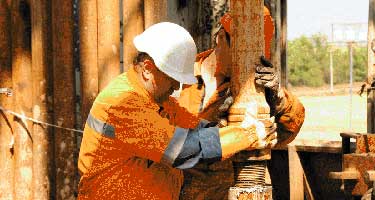Manage Risk for Oil and Gas Companies With a Risk Assessment Checklist
Today, the challenges faced by the oil and gas industry are considerable. Effective business leaders and managers must thoroughly understand them to determine and implement the most effective risk management strategies for their company. There are several commonly recognized best practices for risk management in the oil and gas industry. However, no one-size-fits-all approach will mitigate all actual and potential vulnerabilities. Each company is unique and requires its own customized risk assessment checklist that, at minimum, addresses the following areas:
- Supply, demand, and market dynamics
- Worker health and safety
- Environmental impact
- Cybersecurity
A broad understanding of these vulnerabilities can help businesses pinpoint specific areas they need to address.
Supply, Demand, and Market Dynamics
The market for oil and gas is often quite volatile. Sudden changes in regional economies, wars, or public health can dramatically increase or decrease the supply or demand for oil in a matter of days. And when these shocks occur, the entire industry – including equipment, transport, storage, refining, training, marketing, and software businesses – feels the effects.
Moreover, the industry is highly regulated in most parts of the world, with new laws and regulations expected to continue to emerge. Additionally, many countries are moving to curtail greenhouse gas (GHG) emissions to combat climate change. As a result, nations and multinational organizations are drafting and implementing regulations which will continue to affect both the supply of and demand for oil and gas. And some industries, most notably the automobile industry, are shifting production away from gas-powered products to those powered by alternative fuel sources.
A single weather event in a key region could affect a company’s output or demand. So, it’s essential for oil and gas business leaders to carefully assess all the elements of their supply chain and customer base. It’s just as critical to monitor events continuously. This approach allows adjustments to be made, and new plans developed in real-time to help navigate the market’s inherent volatility.
Furthermore, oil and gas prices in commodities markets are dynamic. That means oil and gas companies must hedge their risks using certain investing strategies. Leveraging derivatives, such as futures, swaps, forwards, and options, can offset the losses a company may face that see a sudden drop in demand. However, these strategies come with their own risks and must be executed carefully.
Worker Health and Safety
While the use of machines and automated tools has helped increase worker safety considerably, oil and gas extraction is still quite dangerous. The work is long, and the working conditions are difficult. And no matter how sophisticated and rugged the machinery is in use, it can break down, resulting in injured workers, making an extraction even more difficult.
Oil and gas companies must design and implement solid worker health and safety plans that cover every aspect of their operation. Doing so is not just a matter of morality and productivity. The federal government requires it. Failing to comply with safety standards exposes companies to serious legal liability.
Part of any effective health and safety plan includes continuous monitoring of worksites, equipment, and conditions. Doing so helps managers identify and remediate safety issues before those issues cause equipment damage or result in injuries. Federal regulations also require businesses to report workplace safety incidents that result in illness or injury. Failing to comply or complying inconsistently introduces considerable legal risks.
Environmental Impact
Broadly, the energy sector has an outsized impact on the environment relative to most other industries. Oil and gas extraction, refining, and distribution result in GHG emissions. However, industry operations also come with the risk of oil spills, the need to dispose of hazardous waste, and other effects. And even if a vendor is directly responsible for an accident, it can be hard for a prominent oil or gas company to avoid taking the blame in the eyes of the public.
There’s also increasing scrutiny of whether companies operate sustainably. What once were esoteric and internal business processes are now regularly dissected on blogs and websites. Some companies have found it more difficult to do business because they directly or indirectly have a substantial negative impact on the environment.
Cybersecurity Risks
Of the four areas of risk management outlined, cybersecurity is the most recent. However, it also potentially poses the greatest risk. Cyber threats continue to grow in scale and scope, threatening businesses and organizations of all sizes and industries. Criminals will target any business from which they believe they can extract a ransom. But the oil and gas industry is also vulnerable to hacking attempts from more than just thieves.
Nation-state and non-nation-state actors have increasingly targeted the oil and gas industry and other critical infrastructure industries for geopolitical advantage. Some attacks are tied to armed conflicts, as oil and gas are critical wartime supplies. And in a global market, some hackers seek trade secrets on behalf of foreign interests.
Oil and gas companies have embraced new digital operational equipment that leverages robotics, machine learning, automation, and the Internet of Things (IoT). With that transformation comes new vulnerabilities. While business efficiency and productivity improve with digitization, potential access points increase. It’s true that hackers can steal corporate data in other industries. However, hackers infiltrating oil and gas networks can also deliberately or inadvertently cause significant physical and environmental incidents. These directly compromise worker safety and the environment.
Companies across the globe are in a fierce talent war for cybersecurity professionals. Oil and gas companies must also recruit and retain talented staff who can stay on top of emerging threats within the context of a unique and highly dynamic sector. These threats do not include outside actors. Instead, they involve internal threats from negligent or disgruntled employees.
Risk Management in the Oil and Gas Industry
Risk management in the oil and gas industry requires business leaders and managers to understand them and use the appropriate tools to evaluate them. Oil and gas companies need the right risk assessment checklist to help them evaluate the unique threats their firm faces. The GoCanvas team has created an effective risk assessment checklist to help you comprehensively assess your worksites.
Liability issues stemming from worker injuries aren’t the only worker health and safety issues leaders and managers must address. Some worker safety issues are a direct result of worker stress. And in an industry distinguished by hard work under tough conditions, businesses must evaluate and mitigate employee stress to mitigate the risk of workplace accidents.
GoCanvas also has developed a stress managers risk assessment tool that can help you gain invaluable insight into how your employees are faring and help you manage risk.
These are just two of the tools that GoCanvas offers business leaders and managers in the oil and gas industry. Our products are aligned with federal OSHA standards and easily customizable to fit your business needs. Visit GoCanvas to learn more about safeguarding your business from market, operational, and organizational risks today.

Stay in Touch!
About GoCanvas
GoCanvas® is on a mission to simplify inspections and maximize compliance. Our intuitive platform takes care of the administrative tasks, freeing our customers to focus on what truly matters – safeguarding their people, protecting their equipment, and delivering exceptional quality to their customers.
Since 2008, thousands of companies have chosen GoCanvas as their go-to partner for seamless field operations.

Check out even more resources

5 Tips to Improve How Your Business Collects Data
Focusing on your business practices for data collection will help you scale your business growth and productivity. Here are some best practices tips to improve…

Solutions to Waste Management Issues For Oil & Gas Companies
Waste management compliance is important in every industry. The oil and gas industry, in particular, has a strong risk of waste emissions…

4 Ways Big Data is Transforming Oil and Gas
Oil and gas companies are getting smart about using the data they collect to gain insights and manage people, equipment, and worksites more effectively…